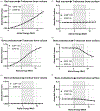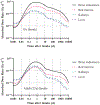Radium dial workers: back to the future
- PMID: 33900890
- PMCID: PMC10563809
- DOI: 10.1080/09553002.2021.1917785
Radium dial workers: back to the future
Abstract
Purpose: This paper reviews the history of the radium dial workers in the United States, summarizes the scientific progress made since the last evaluation in the early 1990s, and discusses current progress in updating the epidemiologic cohort and applying new dosimetric models for radiation risk assessment.
Background: The discoveries of radiation and radioactivity led quickly to medical and commercial applications at the turn of the 20th century, including the development of radioluminescent paint, made by combining radium with phosphorescent material and adhesive. Workers involved with the painting of dials and instruments included painters, handlers, ancillary workers, and chemists who fabricated the paint. Dial painters were primarily women and, prior to the mid to late 1920s, would use their lips to give the brush a fine point, resulting in high intakes of radium. The tragic experience of the dial painters had a significant impact on industrial safety standards, including protection measures taken during the Manhattan Project. The dial workers study has formed the basis for radiation protection standards for intakes of radionuclides by workers and the public.
Epidemiologic approach: The mortality experience of 3,276 radium dial painters and handlers employed between 1913 and 1949 is being determined through 2019. The last epidemiologic follow-up was 30 years ago when most of these workers were still alive. Nearly 65% were born before 1920, 37.5% were teenagers when first hired, and nearly 50% were hired before 1930 when the habit of placing brushes in mouths essentially stopped. Comprehensive dose reconstruction techniques are being applied to estimate organ doses for each worker related to the intake of 226Ra, 228Ra, and associated photon exposures. Time dependent dose-response analyses will estimate lifetime risks for specific causes of death.
Discussion: The study of radium dial workers is part of the Million Person Study of low-dose health effects that is designed to evaluate radiation risks among healthy American workers and veterans. Despite being one of the most important and influential radiation effects studies ever conducted, shifting programmatic responsibilities and declining funding led to the termination of the radium program of studies in the early 1990s. Renewed interest and opportunity have arisen. With scientific progress made in dosimetric methodology and models, the ability to perform a study over the entire life span, and the potential applicability to other scenarios such as medicine, environmental contamination and space exploration, the radium dial workers have once again come to the forefront.
Keywords: Million Person Study; Radium; dial painter; mesothorium.
Conflict of interest statement
Disclosure statement
No potential conflict of interest was reported by the author(s).
Figures









References
-
- Adams EE, Brues AM. 1980. Breast cancer in female radium dial workers first employed before 1930. J Occup Med. 22:583–587. - PubMed
-
- Adams EE, Brues AM, Anast GA. 1983. Survey of ocular cataracts in radium dial workers. Health Phys. 44(Suppl 1):73–79. - PubMed
-
- Aub JC, Evans RD, Hemplelmann LH, Martland HS. 1952. The late effects of internally-deposited radioactive materials in man. Medicine. 31(3):221–329. - PubMed
-
- Azizova TV, Bannikova MV, Grigoryeva ES, Rybkina VL, Hamada N. 2020. Occupational exposure to chronic ionizing radiation increases risk of Parkinson’s disease incidence in Russian Mayak workers. Int J Epidemiol. 49(2):435–447. - PubMed
-
- Baverstock KF, Papworth DG. 1989. The UK radium luminizer survey. In: Taylor DM, Mays CW, Gerber GB, Thomas RG, editors. BIR Report 21: Risks from Radium and Thorotrast. London (UK): British Institute of Radiology; p. 72–76.
Publication types
MeSH terms
Substances
Grants and funding
LinkOut - more resources
Full Text Sources
